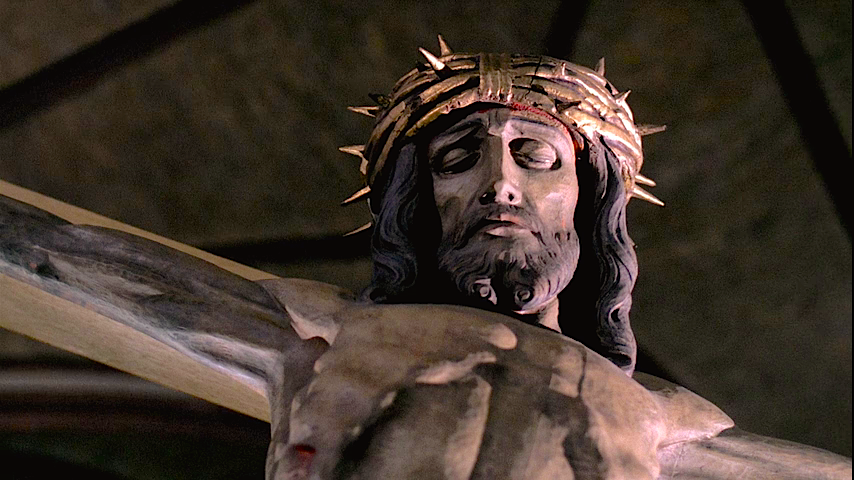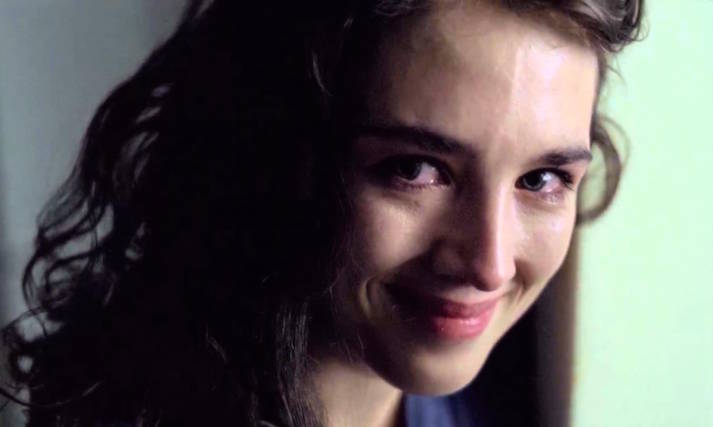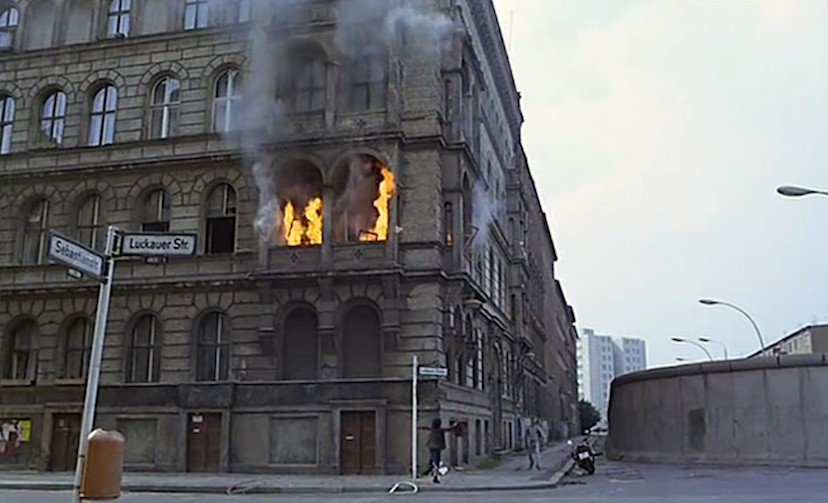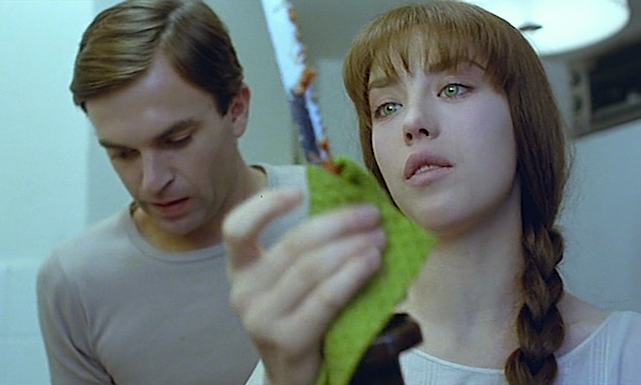By 1995 Communist Poland was long gone. The state no longer restricted the artist or oppressed it’s people. Capitalism was to be embraced. Along with this sudden shift in economy and freedom came many challenges. For the Film Artist, there seemed to be a freedom. A cinema without restriction.
In reality, the entire Polish infrastructure was unstable. The state no longer funded the arts. Film had to be funded privately. However, there was no real film studio or film producers wiling to fund much beyond silly comedies, biographies and other projects that criticized the former Communist regime. When Andrzej Zulawski returned to Poland to film Szamanka (She-Shaman), he had to secure funding from France and Switzerland in order to bring his vision to the screen.
Those of you reading this most likely know who Andrzej Zulawski is, but despite his genius and success he remains a largely marginalized film artist. Best known and accepted in France, he obtained some degree of success there. In the US and the UK he is best known for leading Isabelle Adjani and Sam Neil into the dark, disturbing, twisted and innovative cult film, Possession. If that controversial and infamous 1981 film is his most personal work, where does that place Szamanka?
This might be one of his more philosophical films, but it is unquestionably his most sexually obsessed film. Looking at the movie from a strictly surface perspective (a mistake when it comes to the films of Andrzej Zulawski) this could be interpreted as a frantically impulsive sexual relationship between a wounded and angry Anthropologist and a clearly disturbed young woman. A sort of demented take on the battle of the sexes. However, this is far too simplistic a way to watch or understand this erotic film that hinges on apocalyptic horror.

Passion, love, madness or taming evil?
Iwona Petry & Boguslaw Linda
Szamanka
Andrzej Zulawski, 1996
Cinematography | Andrzej Jaroszewicz
If you’ve not heard of Szamanka or seen it, it is likely due to the fact that upon its release it faced an incredible amount of rage from the Polish Catholic Church. Censorship by the State of Poland may have ended, but a new form of repression had sprung up in the form of Post-Communist Catholic Poland. This tale derived from the ideas of Polish writer, Stanislaw Przybyszewski and his controversial coining of the phrase, Naked Soul and Zulawskis’s desire to wake up the Polish masses with his own sort of “Santanic Antidote” to his two contemporaries of Polish Cinema. While both Kieslowski Krzysztof and Zanussi Krzysztof were both brilliant filmmakers, from the ideology of Zulawski were playing into some spiritual idea to which he took exception.

Who is the Sadist? Who is the Masochist? Or, is this demonic possession?
Iwona Petry & Boguslaw Linda
Szamanka
Andrzej Zulawski, 1996
Cinematography | Andrzej Jaroszewicz
Filled with contradictory ideas around Catholicism, good, evil, sexuality and love this film faced a whole new level of censorship that Zulawski had never faced. Communist Rule was tough, but the unbridled adherence of Religion truly knows no bounds. The film is so graphic sexually that it probably would have been banned anyway, but the controversial ideas of this philosophical, mystical and erotic journey remain blasphemous. The Polish community almost immediately began to call this film The Last Tango in Warsaw. Even though they had not seen it, this was and remains the oft-mentioned joke about Szamanka.
The film has been compared to Lars von Trier’s controversial, Antichrist, in that it depicts a male who suffers the wrath and sexual rage of his female wife. Antichrist plays with ideas around cultural misogyny and grief in equal measure. Like Lars von Trier, Zulawski has been accused of misogyny. The problem with this accusation is that it doesn’t hold up when one watches Szamanka with some knowledge of where it’s maker is coming from and where the film ultimately takes us. It is also important to note that the screenplay was written by Manuela Gretkowska, a young Feminist and acclaimed writer who played a key role in founding The Polish Women’s Party. Certainly Andrzej Zulawski pushes forward his own agenda, but he never veered far from Gretkowska’s script.

Rumors that this was real and not simulated sex has earned the film the nickname of “The Last Tango in Warsaw”
Iwona Petry & Boguslaw Linda
Szamanka
Andrzej Zulawski, 1996
Cinematography | Andrzej Jaroszewicz
Boguslaw Linda was an established Polish movie star when he was cast as Michal, the unhappy and profoundly conflicted anthropologist who has just come into the job of investigating the rarest of anthropological finds. There are more than a few stories about the casting of the female lead. Zulawski was not known to work with “unknowns” or “untrained” actors, but something about Iwona Petry’s beauty and presence deeply fascinated Zulawski. She was just barely twenty years of age when he saw her ordering a cup of coffee. Described as a bit eccentric and a strict vegetarian, Zulawski convinced her that she was meant to be his star and to play the role of Wloszka / The Italian.

An unforgettable cinematic presence and debut which would be her final turn in front of film cameras.
Iwona Petry as Wloszka AKA “The Italian”
Szamanka
Andrzej Zulawski, 1996
Cinematography | Andrzej Jaroszewicz
While Szamanka was a huge critical and commercial failure in Poland — largely because the Polish Catholic Church. Honestly, the film was never even given a chance to screen much at all due to protests and the ultimate banning of the film. However the film scored incredibly well in Italy and France. It was expected that Petry would be a major and perhaps first true Polish female movie star. She didn’t. In fact she has become a huge part of this movie’s infamy. During production the Polish media had a frenzy in reporting that Zulawski was manipulating, forcing and abusing the young woman. Rumors ranged from beatings to forced sex to psychological torture.
Looking back at the situation, it would seem that Zulawski’s dark sense of humor had some fun playing with what were clearly rumors. When the film finally screened to great acclaim at the 1996 Venice Film Festival, Zulawski answered the charges with his typical blunt intellect. There was no truth to any of it. Yet another ploy to set the film up by the oppressive Polish Catholic Church.

Religious symbology and Mysticism loom constantly around these two rage-filled lovers.
Iwona Petry & Boguslaw Linda
Szamanka
Andrzej Zulawski, 1996
Cinematography | Andrzej Jaroszewicz
However, Iwona Petry failed to show up for the premiere. She actually went missing for a short while. Apparently exhausted from the tough shoot and terrified by the media attention she took her money and ran off to India. In 1998 she gave a few interviews and admitted that the sudden brush with fame was far more than she had bargained. A roll of eyes to the rumors that continue in Poland to present day. She returned to university and is now a published fiction writer. She has no interest in returning to the world of acting.
This is a shame as her performance in the film is quite impressive. Iwona Petry had the presence of a movie star and she played the role of the She-Shamen with an almost insane level of erotic energy. One hardly has time to notice the well-trained middle-aged Boguslaw Linda. When Petry is on screen, it is she you watch. And, no. She is not nude the entire time. It is an interesting and terrifying performance. Once you see this odd film, you will never forget her.
Most importantly, you will never forget Szamanka.

The anthropological find of a lifetime: a nude mummified Shaman covered in mystical tattoos and a pouch of ancient hallucinogenic mushrooms
Szamanka
Andrzej Zulawski, 1996
Cinematography | Andrzej Jaroszewicz
Boguslaw Linda’s Michal is a frustrated scientist about to marry a woman for whom he feels no love or passion. During an unseen excavation with his students, a mummy is discovered. It is determined that this mummy is close to 2,000 years old. Michal’s interest in this mummy goes far beyond the academic or scientific when he discovers this is the body of a Shaman.

Touching, connecting and trying to merge with God
Boguslaw Linda
Szamanka
Andrzej Zulawski, 1996
Cinematography | Andrzej Jaroszewicz
The body is incredibly well preserved. Covered in mystical tattoos, they also find a pouch full of what turns out to be hallucinogenic mushrooms. While Michal and his team try desperately to understand the cause of the Shaman’s death, there is only one clue: the back of the Shaman’s skull is crushed. This does not signal the cause of death but an ancient pagan ritual in which after death, the Shaman’s skull is opened to release the potent spirit free.
Andrzej Jaroszewicz’s camera seems to be drawn to offering us views of the Shaman’s rather pronounced penis. And Michal is unable to hold back. He breaks protocol and touches the Shaman with his bare hands. Clearly there is a sense of connection for Michal, but the reason for this is not entirely clear to us or him. It is as if he wants to find a way to truly connect with this ancient dead being. This need verges toward the sexual.

What secrets and powers are hidden in the Shaman mummy?
Szamanka
Andrzej Zulawski, 1996
Cinematography | Andrzej Jaroszewicz
The Anthropologist and his mummy are a a constant subplot of the film. The main interest is on the strange young woman who captures the lustful attentions of the scientist almost as strongly as the mystical-pull of the Shaman. A rude and socially inept, but beautiful woman. We first see Petry’s The Italian as she lunges and plunges her way along a buffet of food which she shovels into her mouth and down her throat as if her hunger can never be satisfied.

Erotic desire beyond reason…
Iwona Petry & Boguslaw Linda
Szamanka
Andrzej Zulawski, 1996
Cinematography | Andrzej Jaroszewicz
She is to rent an apartment owned by Michal. The modest flat was formerly occupied by his brother. The Italian wants the apartment. The deal is done, but signed with a frantic and brutal sort of sex that feels as angry as lust-driven. Like the mummy, Michal seems to want to somehow merge more into this beautiful girl than sexual penetration will allow. And like with her food, The Italian’s erotic desire seems to be unhinged and impossible to satisfy.
Between the ever-mounting frenzied levels of brute force, kink, domination, submission, pain and pleasure, Michal attempts to communicate with this woman of his sexual dreams. She, however, seems more concerned with her consuming passion and seeks more to “commune” than communicate. She is obsessed with him and seems to ache to form a possession of his desires. Not articulate, but psychical in her nature.
Michal is becoming more and more obsessed with her. He attempts to discuss philosophy with her but to not ready interest. He discusses religion with disdain. Here she seems a bit more interested, but it always comes down to sex. Our Anthropologist suspects his fever-pitched lover might be no more than a beautiful idiot. The Italian seems unable to offer him nothing more than hot sex. He wants more.
“You see, that’s why there are common saints, just God’s morons with a soul. No brains.”
This sort of comment seems to cause a pulse within the ever-sexually-rabid woman. And as hard as Michal seems to want to walk away from her, he simply can’t. She mystifies him. Occupies his thoughts. Drives him to rage-fueled sexual encounters. The sex becomes desperate. Yet for her, the sex is almost magical. A sort of erotic ritual.

Michal watches his sleeping lover. Or is she something less or more?
Iwona Petry & Boguslaw Linda
Szamanka
Andrzej Zulawski, 1996
Cinematography | Andrzej Jaroszewicz
He finds himself more miserable with her than he had been with his loveless marriage potential. The mummy no longer holds the power over him. This crude, intolerant, polymorphously perverse, tyrannical and hysterical woman seems to offer an inexplicable power over him.
This is not just unrestrained passion, this is something sinister.
Or is it possibly something that offers our Anthropologist a meaning to his existentially challenged existence. He no longer fits in. Poland offers opportunity, but it seems a false promise. His mummy holds no answers. But there seems to be something bleakly powerful in these cruel sexual encounters. The Italian becomes transformed. Already beautiful, during sex she seems to become transformed to the level of sexual goddess. But the orgasm appears to be more like gasoline tossed on some spiritual fire.
There is no pay off or hope in this sex.

Defile.
Iwona Petry & Boguslaw Linda
Szamanka
Andrzej Zulawski, 1996
Cinematography | Andrzej Jaroszewicz
And as this deeply odd but impossibly fascinating Art House film pulls us deep into this mire of confusion, identity crisis, sexual obsessions, perversions and religious conflict. It is also as the film enters it’s third and final act that Zulawski and Manuela Gretkowska push us into the dark theatrical thinking of Stanislaw Przybyszewski and his outright Satanic symbolism.
For Przybyszewski there is no such thing as “love,” it is nothing but a magical illusion. When Michal meets The Italian he his helpless. There can be no free will here. Michal cannot turn away from his She-Shamen even when he seems to realize this girl’s insanity is something of a mystical and most-likely demonic nature. He is rendered to the state of the somnambulistic when it comes to this darkly magik lover who seems to have access to fully influence him to the very core of his being. This “love” is truly apocalyptic. It does not seem to matter if the She-Shaman influences for good or evil. If her ritualistic sex is served for healing or wounding. For Michal has no choice in the matter.
And, here is the clear separation from the Nihilistic turn of Lars von Trier’s Antichrist. Unlike the husband in that film, Michal is not meeting a mere symbol of angry female energy oppressed by centuries of human cruelty, Michal has fallen prey to a demonic sort of force. He is nothing more than a sort of life-force for the She-Shaman. He is one of those common saints. He has been deceived. His nothing more than brains for the She-Shaman‘s food.
As Stanislaw Przybyszewski might have appraised it, for this man survival is not an option. He must submit to the illusion and power of love. In a strange way, this intellectual is taking part in a consensual murder. In this odd bit of socially conscious cinema, everything is fucked.

God, Faith, Spirituality, and Hope looks down…
Szamanka
Andrzej Zulawski, 1996
Cinematography | Andrzej Jaroszewicz
Without love. Without hope. Szamanka must be satisfied.
Even to write about this true cinematic anomaly makes one feel a little loopy. By the time Andrzej Zulawski’s grim film comes to it’s conclusion the viewer is left spent and more than a little dazed.
The folks at Mondo Vision have done an outstanding job at restoring this deeply weird but exceptional film. Sadly, there are no plans to issue it to VOD or Blu-Ray format. It is only available from them on region free DVD. But they have loaded it with extras. If you’ve an interest in Eastern European cinema or the work of Andrzej Zulawski, you really can’t afford to miss it.
You can find it, and several of Zulawski’s titles here: http://www.mondo-vision.com/szamanka.php
Matty Stanfield, 9.15.2015






























